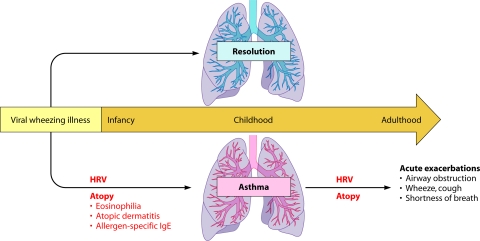FIG. 2.
Relationship between HRV infections and asthma. Infants who develop virus-induced wheezing episodes are at increased risk for subsequent asthma, but even so, most acute wheezing illnesses in infancy resolve with no long-term sequelae. Indicators of heightened risk for developing asthma include wheezing episodes caused by HRV infections and the development of atopic features such as atopic dermatitis, allergen-specific IgE specific for foods or aeroallergens (e.g., house dust, mites, or cat or dog dander), and blood eosinophilia. Once asthma has been established, HRV infections are the most common cause of acute exacerbations, especially in children. As in infancy, atopy is an important risk factor for acute episodes of virus-induced wheezing.

